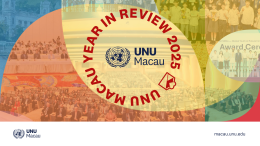The 2024 ACUNS Annual Meeting, cohosted at the United Nations University and the University of Tokyo, convened from June 20-22 to address the theme “Global Governance and Sustainable Development: Revitalizing Research to Support Multilateral Solutions.” The meeting encompassed numerous sessions exploring different aspects of the theme, including a roundtable entitled “It Takes a Village to Raise GenAI: Exploring GenAI’s Impacts on Education and Research.”
Chaired by Jingbo Huang (UNU Macau), the session featured a panel of experts, including Francesco Foghetti (UNU Centre), Jonghwi Park (UNU-IAS), Mark Ray and Stephen Ta’Bois (Government of Cayman Islands), and Antonios Saravanos (New York University). This is Part 4 of the series.
Generative AI (GenAI) represents a significant leap in artificial intelligence, enabling systems to produce new content that extends far beyond traditional data analysis. As a tool increasingly employed in education, it holds the potential to transform how students learn and how faculty teach. However, its integration requires careful navigation to ensure it supports rather than undermines the development of critical academic skills. Drawing on insights from Antonios Saravanos, a computer scientist and professor at NYU, this article exams GenAI's current capabilities, challenges, and future directions in education.
GenAI from a Computer Science Perspective
The current state of Generative AI (GenAI) represents a significant leap forward in artificial intelligence (AI), specifically the empowering of AI to now generate new content that could perhaps be described as novel. Unlike traditional AI, GenAI models are designed to create entirely new data that exhibits characteristics similar to the data on which they were trained. This ability to generate content spans across various domains, including text, images, audio, and even more complex outputs such as videos, software code, and virtual environments.
While these outputs may seem novel, it is essential to recognize that AI creativity is fundamentally based on patterns that it has learned from existing data. While an AI can generate new combinations of these patterns, it does not “create” in the same way a human might.
GenAI primarily relies, for the most part, on neural networks. These are complex computational systems that attempt to replicate the structure and the functioning of the human brain. Neural networks are trained by being fed vast amounts of data from which it learns to recognize patterns, correlations, and structures within the data. Once trained, these AI models are able to take in input and then generate an appropriate output based on the input that was provided. Note the input can vary, for example, text, an image, and so on.
There are several types of neural networks employed in GenAI, each tailored to specific tasks. One of the most popular and widely used architectures is the Transformer model, which serves as the foundation for the popular GPT-4. Transformers are particularly good at handling text-based tasks due to their ability to process and generate human-like language. They work by reading the input in the form of text and then predicting the most likely continuation of that text. A second is what is known as Generative Adversarial Network (GAN). These are highly effective in tasks that involve generating realistic images, audio, or video. They are composed of two parts. A generator, which creates content (e.g., an image) and a discriminator, which evaluates the image in order to determine whether it appears real or fake. The two work together to evolve the generator to make it proficient at producing the desired content.
As the neural networks driving GenAI expand in size and sophistication, their “intelligence” increases proportionally. A clear example of this evolution lies in the progression of the GPT models. Released in 2018, GPT-1 had 117 million parameters and was trained on a relatively modest dataset. GPT-2 expanded to 1.5 billion parameters, with a more extensive and diverse training dataset, resulting in much more sophisticated language generation capabilities. GPT-3, had 175 billion parameters, making it one of the largest language models ever created at the time.
These models also rely on advancements in processing realized by CPUs, technologies such as quantum computing, improvements in information storage, and networking to become reality. At the pace we are developing at some point we may see AI reach and perhaps even surpass human-level intelligence.
GenAI in Educational Practices
The use of GenAI among students is widespread. I have found that all my students use GenAI to support their learning. They are leveraging a variety of GenAI solutions to support their learning, focusing on their strengths and weaknesses, as well as their efficiency. The approach they take involves a lot of self-learning, interacting with the technology, and sharing their experience either in-person or using the internet. This might involve posted guidelines on how to prompt a tool such as ChatGPT to obtain a certain output.
GenAI tools are excellent for sparking creativity and generating ideas. Taking introductory coding course as an example, GenAI is great at presenting sample solutions to problems which can be fused together by students to form their own programs. Coding is nice as it pertains to GenAI because students can try out what is generated and see if it works as it should. So there is an ability to test if the solution generated by the GenAI is correct. Additionally, GenAI is particularly good at teaching technology, for example what snippets of code can generate desired effects, what existing libraries can do, and so on.
GenAI is also useful when support students’ writing. Whether shorter open-ended questions or a longer essay, by overcoming that initial inertia or writer's block. It can help brainstorm topics by providing a wide range of suggestions that might not have been considered otherwise. For instance, a text-based GenAI can offer potential thesis statements, research questions, or essay outlines, helping students to initiate their projects with a solid foundation. Beyond that GenAI can assist in the actual writing process by generating initial drafts.
Generative AI is also quite good at supporting students in building up and further developing their work from a current version. This might be by debugging code to identify errors, or improving the style and coherence of the text, identifying and correcting spelling mistakes, grammar and syntax. Other tasks that GenAI can help stem from the vast amounts of information it has digested as part of its training and in certain solutions its ability to build on that using the internet. This coupled with its ability to summarize key points, identify trends, and synthesize information from multiple sources allows it to explain an idea or topic to a student who needs to quickly get up to speed on a new topic. Finally, GenAI can be of use in helping students assess their current level of understanding. It can quickly generate questions and problems and then assess responses, and even give feedback.
However, this leads to the concerns with students using GenAI. First, there are ethical concerns that need to be taken into consideration. The use of GenAI in academic work raises questions around plagiarism and academic integrity. Students who use GenAI-generated content should properly attribute and that is a skill that we need to teach.
Second, is the accuracy and reliability of the content GenAI tools produce. Despite their advanced capabilities these models are not infallible. They can generate content that is factually incorrect, misleading, or overly simplistic because these models do not possess true understanding as they operate based on statistical patterns rather than genuine comprehension. Consequently, the outputs must be critically evaluated to avoid "hallucinations" or erroneous information. When working with code this is quite easy, one simply compiles and executes the code or runs it through an interpreter and then goes on to examine whether the output is what it should be based on the requirements. However, when the AI has generated text, it either needs to be evaluated by an expert (i.e., the instructor) or needs to be cross-checked against reliable sources. So in short, these are powerful tools, but students need to be careful in their use of them, they should not trust everything an AI generates, rather they should rely on their own judgment as to how to work with what the AI has given them. It is that which is critical for them to master.
Third, there is a concern that over-reliance on GenAI tools might hinder the development of essential skills like critical thinking, problem-solving, and effective communication. So incorporating exercise where students practice tasks such as generating ideas are paramount to ensure students develop such abilities.
GenAI in Transforming Course Design and Personalization
Beyond student applications, GenAI offers significant opportunities for improving faculty efficiency, particularly in course preparation and personalized learning. Faculty members, being subject-matter experts, are well-positioned to leverage AI effectively—they can quickly identify and discard any AI-generated inaccuracies (i.e., “hallucinations”). This makes them an ideal category of users for GenAI tools.
Concerning faculty efficiency in course preparation, the tasks involved in designing and updating course syllabi, developing lecture materials, creating assignments, and preparing examinations are time-consuming, often repetitive, and at times require synthesis from multiple sources. GenAI can streamline these processes by automating the generation of initial drafts for syllabi and course outlines, which faculty can then customize to fit their specific teaching objectives and institutional requirements. It can also be used to make repetitive changes as directed by the faculty on existing documents to update them.
Certain solutions can now work with common file formats such as docx, pptx, and xlsx. This means that the AI can output a Word document, a Powerpoint presentation, or even an Excel spreadsheet. Such automation not only saves valuable time but also affords the faculty the time to ensure that course materials are consistently up-to-date with the latest developments in the field.
Concerning the personalization of learning materials, every student has unique learning preferences, strengths, and areas for improvement. GenAI can help generate customized content tailored to individual students or specific groups of students, addressing their distinct learning needs and preferences. For instance, visual learners might benefit from AI-generated infographics and diagrams, while those who prefer textual explanations could receive more detailed written content.
Additionally, GenAI can create adaptive learning paths that adjust the complexity and pace of material based on each student's progress, ensuring that all students remain engaged and challenged appropriately. Such personalization could extend beyond content delivery to include personalized assessments and feedback. GenAI can design quizzes and assignments that align with each student's learning journey, providing targeted feedback that highlights their strengths and identifies areas for growth. By fostering a more individualized learning experience, GenAI helps to enhance student engagement, motivation, and ultimately, academic success. However, always keep in one's mind that the AI needs to be supervised by faculty as the materials that are generated need to be reviewed by an expert to ensure that they are not “hallucinations”.
Previous blog posts of this series:
Part 1 It Takes a Village to Raise GenAI: Exploring GenAI’s Impacts on Education and Research
Part 2 It Takes a Village to Raise GenAI: Insights from the Cayman Islands Education Sector
Suggested citation: Antonios Saravanos., "It Takes a Village to Raise GenAI: Insights on GenAI in Education from Computer Science and Teaching Practices," UNU Macau (blog), 2024-10-14, 2024, https://unu.edu/macau/blog-post/it-takes-village-raise-genai-insights-genai-education-computer-science-and-teaching.



